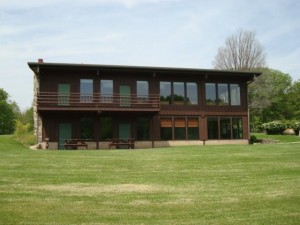Did You Know: Paul Miller – Camp Pine Lake’s Greatest Visionary
Paul Miller – Camp Pine Lake’s Greatest Visionary
by Gordon Hoffert
 No name is more closely connected with Camp Pine Lake’s Friendship Lodge than Paul Miller. To Paul, Friendship Lodge was more than just a multi-purpose building, it represented a crowning achievement in the mission to which he had dedicated his ministry: to train and empower young people as servant leaders in the Church of the Brethren. Its construction and completion is due to the herculean efforts of this one man and the countless brigades of volunteers he inspired.
No name is more closely connected with Camp Pine Lake’s Friendship Lodge than Paul Miller. To Paul, Friendship Lodge was more than just a multi-purpose building, it represented a crowning achievement in the mission to which he had dedicated his ministry: to train and empower young people as servant leaders in the Church of the Brethren. Its construction and completion is due to the herculean efforts of this one man and the countless brigades of volunteers he inspired.
Paul grew to adulthood in the 1930’s, a member of the South Waterloo Church of the Brethren. His generation was the first to benefit fully from the denomination’s growing emphasis on district camping and youth ministry. The earliest effort to organize youth activities outside of Sunday Schools began with the Christian Workers Society in 1903. Its aim was to promote growth in fellowship and leadership skills. The Northern Plains District (then called the Tri-District) fell in step with this movement. A district camping program began in 1921. During these early years of camping, the Brotherhood would send out some of its top leaders to mentor and inspire the campers. In 1932, the camping program moved to its present location, the Meeker YMCA camp, but was owned by the Y until the district purchased it in 1954.
In the early 1930’s a Brethren Young People’s Department was organized by the Brotherhood and Paul became its district president. Paul also participated in the “Hilltop Retreats,” a movement begun by Dan West to train leaders by gathering together selected district youth. Paul belonged to this group, which strove for “disciplined fellowship.” Their mission was to develop “effective leaders for young people’s work in the Church of the Brethren – effective because they are essentially healthy mentally and physically; free to give what they have, and growing into greater effectiveness.”
Paul’s first career choice was to become a high school ag teacher. He attended Iowa State University for one year, but then experienced a call to ministry. It occurred during an event he was attending at Camp Pine Lake. In the stillness of the evening he went for a walk around the lake. He stopped for a moment and felt God’s presence moving him in a new direction, into a vocation as a pastor. He transferred that fall to McPherson college and from there went to Bethany Seminary. He and his wife, Ellen, spent most of their years in ministry serving churches in this district.
Paul maintained his active involvement in the district’s camping program throughout the 1940’s and 50’s. The purchase of Camp Pine Lake in 1954 was accompanied by a host of challenges. The original buildings were falling into disrepair. First and foremost was the need for new cabins and shower facilities. These were constructed on the 10 acres of land that bordered the original camp. Then, in the early 1960’s it was time to build a lodge that could serve as the focal point for nourishing and building up the Body of Christ.
Paul managed to complete the project for around $20,000.00, an unthinkable amount until one factors in the boundless energy and irrepressible optimism of its director. The plans were drafted for free because Paul had the temerity to ask a non-Brethren neighbor, an architect, to donate them. He became a master scavenger as buildings were demolished in the path of the new interstate highway corridor.
Paul would make a weekly drive up to the camp from the Panther Creek Church with a group of volunteers in tow, among them Earl Deardorf, the camp manager at that time. After a week’s work, Paul returned to Panther to squeeze in his pastoral duties and prepare for Sunday. Then it was back up to camp the following week. Youth camps proved a fertile field for volunteer recruitment. For his drive in pushing the project forward, Paul earned a nickname lifted from pages of scripture. He was called “Pharaoh.” With so much unskilled labor at work, shortcuts sometimes became the order of the day. One worker suggested, “You can’t find a square corner in the building.” But the construction, though not perfect, was sturdy and Friendship Lodge has served as an anchor for the camping program for over 50 years.
It’s coming up on a century now since the movements in the Church of the Brethren – the Christian Workers Society, Brethren Young People’s Department, and Hilltop Retreats – inspired young people like Paul Miller to view camping as integral to the future health of the church. The culmination of Paul’s vision, Friendship Lodge, now provides a space for each new generation to discover a call that Paul heard on a quiet night just a short walk away.
Sources:
Judy Miller Woodruff (Paul’s daughter)
History of the Northern Plains Church of the Brethren: 1844-1977

No comments yet
Comments are closed